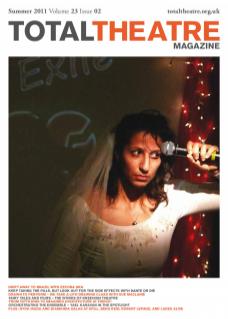With summer comes the street arts season. The announcement of the new Arts Council National Portfolio, reported on in this edition, demonstrates that outdoor performance in public spaces is being taken reasonably seriously these days, with a number of key companies and projects coming onto the portfolio.
It’s good to see established artists and initiatives receiving support, but an ongoing question for the street arts sector is: how do we train the next generation of artists? For most of the current highprofile names are, for the most part, self-taught, ‘growing up in public’ being the rule of thumb.
But for better or worse, this DIY ethos has been slowly shifting and regular readers will have noticed that we have been reporting on training and professional development opportunities for street artists over recent years. So we are pleased to be publishing a reflection on the Lakes Alive professional development initiative, the Mintfest International Summer School for Street Arts, now entering its second year as part of Mintfest, Kendal’s festival of street arts.
News of these sorts of opportunities, where relative newcomers work alongside experienced artists, is always welcome. It’s also good to note that this country’s first BA in Street Arts, at University of Winchester, is now firmly established, and to learn of the university’s support in setting up the Emerge showcase for budding street artists, which is linked to the very well established Hat Fair (which claims, probably rightly, to be the UK’s first street arts festival).
Some might argue that it is vocational, rather than academic, training that is needed, but at the better university performing arts departments, the development and support of sound selfmotivated and dedicated personal artistic training is at the heart of the education. For no matter what your chosen artform or mode of practice, to truly develop and grow as an artist you need tenacity – and an awareness that inspiration may be important but daily practice is equally so.
Yet theatre is by nature a collaborative form: how best to train and develop as a theatre-maker? And if you are not a newcomer, how best to challenge yourself in your practice, and find new ways of working?
The DRIFT International project is an artists’ residency programme that moves from country to country, providing an opportunity for those working in theatre or performance to refuel and recharge, and to explore new ways of working and new collaborations. In this issue we bring you a reflection on one particular DRIFT which took place in Brazil earlier this year.
Elsewhere in the magazine, you’ll find our usual eclectic mix of artist diaries and reflections on contemporary practice – including a feature by Terry O’Donovan of dANTE OR dIE, and the latest candidate for our Voices feature, Yael Karavan.
Another of our regular slots, The Works, focuses on Cornwall’s finest, Kneehigh, and our Being There show, viewed from three different angles, is Sue MacLaine’s Still Life: An Audience with Henrietta Moraes, seen at the Brighton Festival Fringe.
Our Reviews pages include work seen across the country, from The Mill in Bradford to Lepage in London and Benji Reid in Lancaster. There are also reports from SPILL Festival of Performance at the Barbican, Fierce! in Birmingham and the Coming Up event for emerging artists.
As always, comments on this issue and suggestions for future editions welcome.

